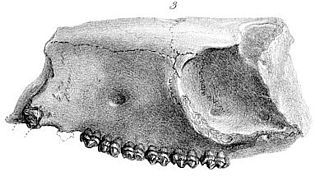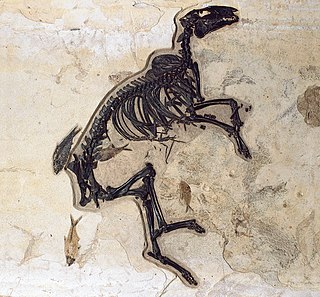
Equidae is the taxonomic family of horses and related animals, including the extant horses, asses, and zebras, and many other species known only from fossils. The family evolved around 50 million years ago from a small, multi-toed ungulate into larger, single-toed animals. All extant species are in the genus Equus, which originated in North America. Equidae belongs to the order Perissodactyla, which includes the extant tapirs and rhinoceros, and several extinct families.

Gastornis is an extinct genus of large flightless birds that lived during the mid-Paleocene to mid-Eocene epochs of the Paleogene period. Fossils have been found in Europe, Asia and North America, with the remains from North America originally assigned to the genus Diatryma.

Hyracotherium is an extinct genus of very small perissodactyl ungulates that was found in the London Clay formation. This small, fox-sized animal is considered to be the earliest known member of Equidae before the type species, H. leporinum, was reclassified as a palaeothere, a perissodactyl family basal to both horses and brontotheres. The remaining species are now thought to belong to different genera, such as Eohippus, which had previously been synonymised with Hyracotherium.

Mesohippus is an extinct genus of early horse. It lived 37 to 32 million years ago in the Early Oligocene. Like many fossil horses, Mesohippus was common in North America. Its shoulder height is estimated at about 60 cm.

Orohippus is an extinct equid that lived in the Eocene.

Propalaeotherium was an early genus of perissodactyl endemic to Europe and Asia during the early Eocene. There are currently six recognised species within the genus, with P. isselanum as the type species.

Eohippus is an extinct genus of small equid ungulates. The only species is E. angustidens, which was long considered a species of Hyracotherium. Its remains have been identified in North America and date to the Early Eocene.

Oxyaena is an extinct genus of placental mammals from extinct subfamily Oxyaeninae within extinct family Oxyaenidae, that lived in Europe, Asia and North America during the early Eocene.

The evolution of the horse, a mammal of the family Equidae, occurred over a geologic time scale of 50 million years, transforming the small, dog-sized, forest-dwelling Eohippus into the modern horse. Paleozoologists have been able to piece together a more complete outline of the evolutionary lineage of the modern horse than of any other animal. Much of this evolution took place in North America, where horses originated but became extinct about 10,000 years ago, before being reintroduced in the 15th century.

Notharctinae is an extinct subfamily of primates that were common in North America during the early and middle Eocene. The six genera that make up the group contain species that are among the most primitive of the adapiform group, which is one of the most primitive groups of primates. The evolutionary history of this subfamily has been comparatively well documented and has been used to argue for evolutionary gradualism. Though it is generally accepted that adapiforms gave rise to modern day lemurs and lorises, it is not currently known which branch of Adapiformes these living species are most closely related to. Notharctines became extinct in the middle Eocene, most likely because of a combination of factors including climatic change and competition with other North American primates.

Pelycodus is an extinct genus of adapiform primate that lived during the early Eocene (Wasatchian) period in Europe and North America, particularly Wyoming and New Mexico. It is very closely related to Cantius and may even be its subgenus. It may also have given rise to the Middle Eocene Uintan primate Hesperolemur, although this is controversial. From mass estimates based on the first molar, the two species, P. jarrovii and P. danielsae, weighed 4.5 kg and 6.3 kg respectively and were frugivores with an arboreal, quadrupedal locomotion.

Protorohippus is an extinct species of equid that lived in the Eocene of North America.

Hyopsodus is a genus of extinct early ungulate mammal of the family Hyopsodontidae, a group associated with or basal to the Perissodactyla. Fossils of this genus have been found in the Eocene of North America, especially the Bighorn Basin region of the United States. It has also been found in Eurasia.

Homogalax is an extinct genus of tapir-like odd-toed ungulate. It was described on the basis of several fossil finds from the northwest of the United States, whereby the majority of the remains come from the state of Wyoming. The finds date to the Lower Eocene between 56 and 48 million years ago. In general, Homogalax was very small, only reaching the weight of today's peccaries, with a maximum of 15 kg. Phylogenetic analysis suggests the genus to be a basal member of the clade that includes today's rhinoceros and tapirs. In contrast to these, Homogalax was adapted to fast locomotion.
The Hannold Hill Formation is an Early Eocene (Wasatchian) geologic unit in the western United States. It preserves the fossilized remains of the ray Myliobatis and gar.

The Wasatch Formation (Tw) is an extensive highly fossiliferous geologic formation stretching across several basins in Idaho, Montana Wyoming, Utah and western Colorado. It preserves fossils dating back to the Early Eocene period. The formation defines the Wasatchian or Lostcabinian, a period of time used within the NALMA classification, but the formation ranges in age from the Clarkforkian to Bridgerian.

The San Jose Formation is an Early Eocene geologic formation in the San Juan Basin of New Mexico and Colorado.
The Las Tetas de Cabra Formation is a geologic formation in Mexico. It preserves fossils dating back to the Wasatchian of the Early Eocene period.

Systemodon is a genus of early Eocene mammal of Wasatchian age. It was one of many mammals originally considered the earliest horses, long classified in the genus Hyracotherium. These were dog-sized animals that in life would have looked vaguely like a paca, mara, or chevrotain The type species, S. tapirinus, is represented by 24 individuals from a locale called the Castillo pocket in the Huerfano Formation of Colorado. This well-preserved deposit allows researchers to reconstruct aspects of the environment and lifestyle of the species.
Apatemys is a member of the family Apatemyidae, an extinct group of small and insectivorous placental mammals that lived in the Paleogene of North America, India, and Europe. While the number of genera and species is less agreed upon, it has been determined that two apatemyid genera, Apatemys and Sinclairella, existed sequentially during the Eocene in North America. The genus Apatemys, living as far back as 50.3 million years ago (mya), existed through part of the Wasatchian and persisted through the Duchesnean, and Sinclairella followed, existing from the Duchesnean through the Arikareean. Examinations of specimens belonging to the genus Apatemys suggest adaptations characteristic of arboreal mammals.



















